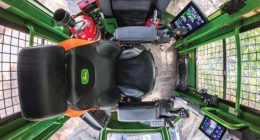Get opinion pieces, letters and editorials sent directly to your inbox weekly!
At 190 square miles, Wharton State Forest is too big to be heavily policed so other controls and public support are essential. A state forestry truck is seen touring the Quaker Bridge section and checking damage from vehicles in 2015.
People long considered the New Jersey Pine Barrens remote, inhospitable and with little obvious commercial value — and didn’t care much what was done there. With the discovery of its wildlife riches and extraordinary water resource underground, people started to care a lot about what happened in the pinelands. Thus began the fight over access that continues to this day.
There have been many attempts to satisfy legal pinelands drivers and human-powered fans of nature. The state Department of Environmental Protection is in the midst of another one, the most deliberate yet.
All legal users agree that the problem is the unlawful use of off-road vehicles — ATVs, trucks and dirt bikes — that seriously damages sensitive and protected habitats. Despite decades of attempts, addressing that while allowing benign access has remained elusive.
In 2010, the state seemed to make a good start with increased penalties for illegal riding and a requirement that ATVs be registered and display a numbered registration decal. But that was delayed until the DEP could find and designate state-owned land open to off-road vehicles — which it never did and the crucial ability to identify offenders was dropped.
The DEP proposed in 2015 to ban street legal vehicles from half the dirt roads in Wharton State Forest, the largest property in the state park system, just north of Hammonton. There was strong opposition from law-abiding users, who follow the rules and help counter damage by building gates to block further damage of recovering areas. The road closings were dropped and a compromise was offered. Nearly all 500 miles of dirt road would remain open and enforcement would be beefed up. In a 190-square-mile forest too big to be heavily policed, nothing changed much.
This past February, the DEP announced two promising pinelands initiatives to fulfill what Commissioner Shawn LaTourette called the state’s obligation to balance the competing demands of all users of its natural resources. Under one it expected to take effect this year, vehicle owners would have to register with the state and obtain a permit in order to go off-road in the pinelands. The other would create an interactive map of the pinelands showing where off-road-vehicle use is approved or prohibited.
Those, apparently, turned out to be larger tasks than anticipated, and in late spring the DEP refined and enlarged its effort to find and implement a solution. The public would be surveyed on access and use of the pinelands, stakeholders would be consulted, and a plan for Wharton would be developed (and expected to serve as a model for other state lands).
The permit approach continues. A DEP spokesman recently told New Jersey 101.5, “The specifics of the permit process are in development, but in general, permits would be issued for vehicle use of specified routes developed through input received via the access survey and stakeholder meetings.” And the DEP still plans to publish a map showing where access to Wharton is legal.
We’re hopeful that the new efforts work and enjoy broad public support. We are very impressed with the DEP’s diligence, resilience and continued sensitivity to all who abide by the law regardless of their differences in how they appreciate and use the pinelands.
This is how intractable problems are eventually conquered, behaviors are adjusted and elusive widespread satisfaction is gained. A success with this common-usage challenge would hold lessons for other enduring conflicts in society.
Get opinion pieces, letters and editorials sent directly to your inbox weekly!
SHAMONG — Advocates for New Jersey’s ecologically sensitive Pinelands region say the state is not doing nearly enough to protect the fragile w…
Sign up for a digital subscription to The Press of Atlantic City now and take advantage of a great offer.
At 190 square miles, Wharton State Forest is too big to be heavily policed so other controls and public support are essential. A state forestry truck is seen touring the Quaker Bridge section and checking damage from vehicles in 2015.
Get up-to-the-minute news sent straight to your device.

